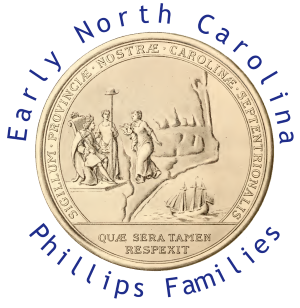Ashe County Phillips Families
From ENC Phillips Group Wiki
Ashe County was formed from Wilkes County in 1799. Part of the county was later divided and Watauga was formed in 1849 taking the southern half.
History
Historical evidence shows that Ashe county was inhabited by Native Americans, which included the Cherokee, Creek, and Shawnee tribes. Pieces of broken pottery, arrowheads, and other Native American artifacts have been found, indicating their presence. Most of these artifacts have been found in the Old Fields area of Ashe County.
The earliest Europeans to explore Ashe County were Bishop Augustus Gottlieb Spangenberg - head of the Moravian Church in America - and his associates, Timothy Horsefield, Joseph Mueller, Henry Antes, Johan Merck, and Herman Loesch. Bishop Spangenberg wrote about his journey in Ashe in a diary that has been preserved by the Moravian church. He was given 100,000 acres (400 km²) in Virginia as a place for his fellow Moravians to settle. The only one of Spangenberg's group to return and permanently settle in Ashe County was Herman Loesch. Other early settlers were David Helton, William Walling, William McLain and Daniel Boone, the famous pioneer. With the exception of Boone, these men and their families all settled in Ashe in 1771.
During the Revolutionary War one skirmish was fought in Ashe County. It is called the "Battle of the Big Glades". The battle was fought in July 1780 between a force of Americans, led by Captain Robert Love, and a force of 150 British Loyalists on their way to Charlotte to join Lord Cornwallis, the British commander in the Southern colonies. The Americans won the skirmish.
In the 1780s, Ashe County was considered a part of the "State of Franklin". It consisted of three counties - Washington, Greene, and Sullivan. Ashe was considered to be a part of Washington County. The "State of Franklin" marked the beginnings of the State of Tennessee. Ashe County did not formally become a part of North Carolina until 1785. In 1799, Ashe was finally pronounced an official county of the United States and of North Carolina. Ashe County was named after Samuel Ashe, the Governor of North Carolina from 1795 to 1798. From 1807 to 1913, Ashe went through numerous boundary changes.
In 1849, the southwestern part of Ashe County was combined with parts of Caldwell County, Wilkes County, and Yancey County to form Watauga County. In 1859, the eastern part of the remainder of Ashe County became Alleghany County.
Ashe County has produced, or been visited by, several prominent people. Among them are Monte Weaver, a famous baseball player, who pitched for the Washington Senators and pitched a World Series game in 1933. After being traded from the Senators, he pitched for the Boston Red Sox, before being called into service in World War Two. Weaver died in 1994. Helen Keller visited an Ashe County native, Marvin Osborne, in 1944 when he was wounded in France in World War Two. Loretta Lynn sang at the Central Food Market in West Jefferson in the 1940s. (The Central Food building formally housed a locally owned auto parts store, but is now vacant.) In 1998, then-President Bill Clinton and his Vice-President, Al Gore, held a ceremony on the banks of the scenic New River to designate it as an American Heritage River.[1] After the ceremony, both men had lunch at the historic Glendale Springs Inn, also located in Ashe County.[2] Fiddle player G. B. Grayson was born in Ashe County in 1887.[3]
Phillips Families
A member of Phillips DNA Family Group 9 can be traced to Ashe County. More information can be found below.
Phillips DNA Group 9
See also
Rowan County Phillips Families
References
- ↑ http://www.epa.gov/rivers/sor/sornew.pdf
- ↑ Glendale Springs Inn and Restaurant, County Inn and Bed & Breakfast, West Jefferson, NC and Boone, NC Lodging and Accommodations
- ↑ Barry McCloud (ed.), Definitive Country: The Ultimate Encyclopedia of Country Music and its Performers (New York: Berkley Publishing Group, 1995), p. 340.
